A Life In Cartoons: An Interview with New Yorker Cartoon Editor Bob Mankoff
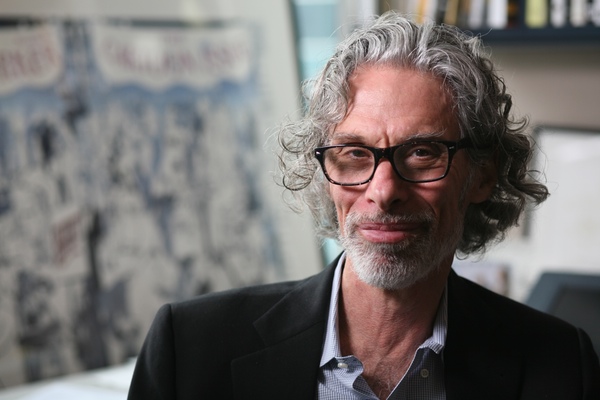
Humor is mankind’s greatest blessing. -- Mark Twain
The most widely reprinted New Yorker cartoon shows an executive on the phone with the caption: "No, Thursday's out. How about never—is never good for you?" The punch line has become a part of the vernacular and earned the cartoonist, Bob Mankoff, mention in The Yale Book of Quotations as well as display on t-shirts, coffee cups, thongs and more.
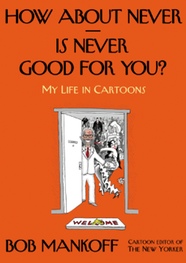 And
now New
Yorker
cartoon editor and acclaimed cartoonist Mankoff uses the line for his
new book of memoir, cartoon history and humor psychology, How
About Never—Is Never Good for You? My Life in Cartoons
(Henry Holt and Company).
And
now New
Yorker
cartoon editor and acclaimed cartoonist Mankoff uses the line for his
new book of memoir, cartoon history and humor psychology, How
About Never—Is Never Good for You? My Life in Cartoons
(Henry Holt and Company).
In his new book, Mankoff details his own path to perhaps “the best job in the world,” as well as providing a history of cartoons and how cartoons evolved in The New Yorker since its founding in 1925, as well as how cartoons in the magazine work—along with hints on how to win its weekly caption contest.
Mankoff almost completed a doctorate in experimental psychology but, as he recounts in his book, his lab animal died. He turned to cartooning as a career in the early 1970s, and was determined not only to publish, but to publish in The New Yorker. He was a determined researcher. He sat in the New York Public Library and read through every issue of the magazine since its inception.
Mankoff submitted more than 500 cartoons to The New Yorker until one was accepted and published in 1977. And he continued to submit. Within a couple of years, he had a contract to contribute work regularly.
In 1992, Mankoff established the Cartoon Bank, a licensing platform for New Yorker cartoons, and in 1997, he took the helm as cartoon editor. The magazine has published more than one thousand of his cartoons. In recent years, he has turned much of his attention to mentoring a new generation of cartoonists.
Mankoff is also the author or editor of a number of books, including The Naked Cartoonist: A New Way to Enhance Your Creativity, and The Complete Cartoons of The New Yorker, published in 2004 and featuring every cartoon published to that point since the magazine's debut in 1925.
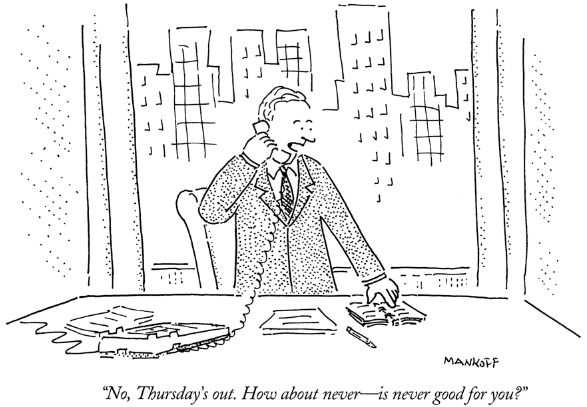
How About Never has been praised for its explanation of New Yorker humor, historical background, and Mankoff’s candid and funny writing. Janet Maslin wrote in the The New York Times: "This is a generous book, giving abundant credit to both the older generation of cartoonists whom the young Mr. Mankoff hero-worshiped to the new blood he has brought to the magazine during his tenure." And Publisher’s Weekly on How About Never: “Mankoff traces his career from his youth in New York City, when the fluent Yiddish spoken by his mother—a language "combining aggression, friendliness, and ambiguity, a basic recipe for humor"—heavily influenced him. The book generously displays New Yorker cartoons by Mankoff and others from earlier (Peter Arno, Charles Addams) and contemporary (Roz Chast and Bruce Eric Kaplan) generations of artists. In this way, How About Never serves up not only a mini-collection of great cartoons but also as a look at the shift in styles through the editorships of legendary William Shawn, Tina Brown, and current editor David Remnick.”
As cartoon editor, Mankoff helps select from the one thousand cartoons the magazine receives each week the 17 or so that will make it into print.
Mankoff graciously took time from his frantic schedule to see me on a Wednesday, right before his weekly meeting with New Yorker editor David Remnick to decide on the cartoons for the upcoming issue.
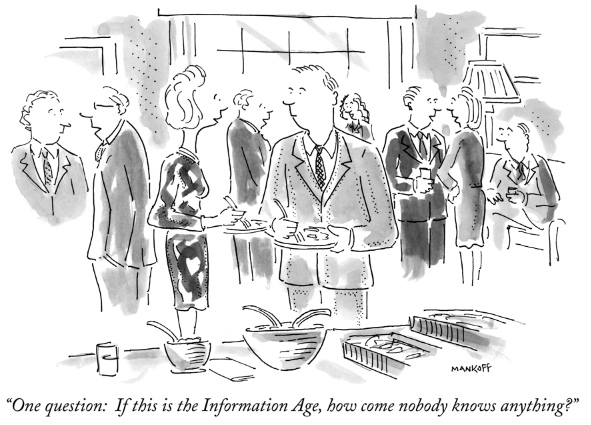
Robin Lindley: Your new book is wide ranging. It’s your memoir, a history of New Yorker cartoons, an anatomy of cartoon humor, and more. How did you come to write this book now?
Bob Mankoff: I had failed at writing a book called A Brief History of Humor. I was very interested in the history of humor and made a presentation to someone at Harper Collins and got an advance to write a book.
I got deep into the history but I was supposed to be funny and tell the history, and that was hard. But in terms of my own history, I found it was easy to be funny and convey the history. I found the right topic in myself and The New Yorker and the overlap between the two, which would be interesting enough to people.
I think people are interested in me because of my position at the New Yorker, not so much who I am. With some celebrities, you want to know what they ate for lunch, everyone they slept with, and all that. My joke is that I remember everyone I slept with and not because I have a great memory.
I’m not that interesting. Well, I’m sort of interesting, but people are interested in The New Yorker, so this story is about me growing up and the arc of me becoming a cartoonist and then cartoon editor and why that’s important to more than me.
Robin Lindley: Your own story is fascinating. You’ve said you’re a made cartoonist but a born comic.
Bob Mankoff: Yes. I was interviewed yesterday by Jim Kelly, a really nice guy on the staff, and he asked me, “If you weren’t a cartoonist, what would you have been?” I said, “I would have been a standup.” But when I got out of grad school in ’73, it was hard to be a standup. There weren’t many comedy clubs. There wasn’t this clear thing that you were.
I could draw a line and was funny and I had always done cartoons. I knew my strengths and my limitations. I wasn’t going to be someone who could draw every possible scenario like Jack Ziegler. I had a focus on what was conceptually strong.
Cartooning and the iconic nature of it enabled me to use whatever artistic ability I had along with the charm I developed in my own peculiar style to create a pleasing picture within iconic formats, whether it was the desert island, or the grim reaper, or lemmings. In a way, you could become a cartoonist almost like someone could become a Japanese painter. Of course you’re talented, but you learn the forms and the forms could be combined.
Where I was never a good enough artist to be an illustrator, I could illustrate my own ideas through cartoons. And I did have a strong comic sense and a strong idea sense, which I think comes through in the book. My cartoons are ideas.
One of the revelations I had when I was younger and looked at The New Yorker was that even though The New Yorker was great and I admired it’s cartoons immensely, I still thought, “I can do this.” I had that confidence that I think you need to succeed.
I was just visiting with a new cartoonist who lives in Taipei. His name is Ed Steed and he is an architect. He is only 25 or 26 now. I asked him how he started selling cartoons to The New Yorker. He said he didn’t know much about The New Yorker. He looked it up and looked at the cartoons and he said to himself, “I can do this.” So you have to have a certain respect but also confidence.
Given my background, I have a certain amount of chutzpah, which is Yiddish for gall but it more than that. It’s gall and balls and whatever is necessary to open your mouth when you see the gold ring and go for it.
That was the confluence of talent and time and luck. In 1972, Lee Lorenz became the cartoon editor and he was looking for [new art]. In ’73, it was Jack Ziegler and Arnie Levin. I had my first cartoon published in ’77, then Roz Chast in ’78, Michael Maslin in ’78, Mick Steven in ’78. There was a whole generation that came in.
In the book, I say I reprised that arc again with this new generation. You open The New Yorker magazine now and look at the recent issue. [Bob Mankoff reads from list of artists in Table of Contents of the May 12, 2014 issue.] Avi Steinberg, new kid. Michael Crawford, we got him in the eighties. [Farley] Katz is new. Edward Steed is new. Kim Warp is new. Harry Bliss was ’97, ’98. I brought him in. Christopher Weyant is new. Amy Hwang is new. Roz Chast of course has been with us. Zachary Kanin, came with me [in 2004]. Barbara Smaller, a little bit before. Benjamin Schwartz is new. Sam Gross, forever and always. Emily Flake, new. P. C. Vey, previous generation, and William Hamilton and Jack Ziegler, previous generation. So you can see most of them are new people.
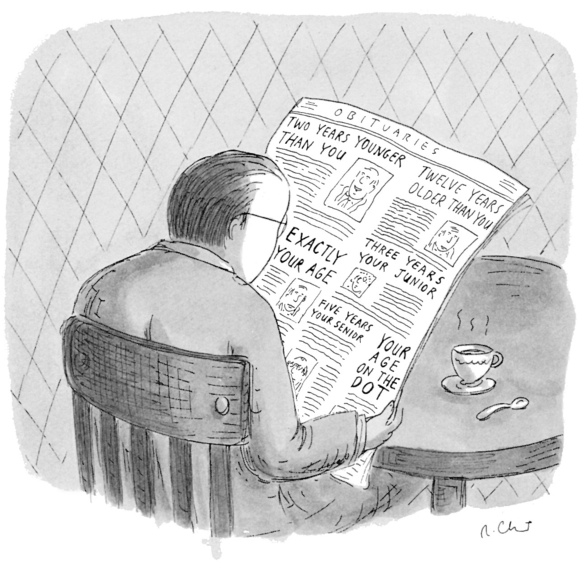
Robin Lindley: You are also an impressive researcher. You went to the library and went through all back issues of The New Yorker. You were determined to be a New Yorker cartoonist.
Bob Mankoff: I looked at the back issues in the New York Public Library. My dad grew up on the lower East Side in the early twentieth century and educated himself at the New York Public, not ever graduating from high school or college.
In the seventies I went to the New York Public Library when you could take out every volume. You still can. And the whole history of the magazine was there in those volumes. I opened them up and looked page by page and became inspired. I learned there was no one thing that was a New Yorker cartoon, but when you looked altogether, there was a New Yorker cartoon.
Robin Lindley: And you submitted to other magazines.
Bob Mankoff: I did. But there weren’t as many magazines left as in the fifties and sixties at the height of magazine cartooning. The cartoons started to die a slow death and we were the last one standing in magazines that mattered. There’s Playboy, but those cartoons certainly have not had the influence of New Yorker cartoons.
The power of The New Yorker cartoon begins with The New Yorker, the great American magazine, that gives an imprimatur to a cartoon. And there’s a lightness and flexibility that the cartoons give The New Yorker that has to do with a sense of humor and a sense of play within the most serious, intelligent magazine in the United States. In this serious magazine are jokes, but more than jokes. With Saul Steinberg or William Steig or Roz Chast or the work I’ve done, we use a sense of humor as a way of thinking about things or reflecting on things or coping with things or illuminating things that are important.
Robin Lindley: And, in your book, you write a brief history of magazine cartooning and how The New Yorker revolutionized the cartoon. You note that earlier cartoons, like those in Punch, were often overdrawn and not too funny.
Bob Mankoff: Yes, not too funny to us. There was an evolution of the form. Those were very complicated drawings in Punch. There was a separate person who would draw and a separate person would create the engraving template and another person would come up with the joke. They were entirely worked out skits where people talked back and forth to one another. That process seems incredibly tedious but it was entertaining because that was the form then.
But The New Yorker with Thurber gave cartoonists the voice of the vernacular; the way people actually spoke, so you identified with it. And Thurber gave a loopiness, a playfulness. [Peter] Arno gave it a sensuality which wasn’t salacious. The Playboy cartoons are all wink-wink jokes. The Arno cartoons were denoting what the world was actually like and that sex was part of the dynamic of it. To ignore that was to ignore what was going on in the life of the city. And Saul Steinberg was a revelation. He started as a gag cartoonist but he was a philosopher. William Steig was influenced by [Wilhelm] Reich and the orgone box. He started as a joke cartoonist, but with The Lonely Ones [and later] he probed in a psychoanalytic way the human types.
The New Yorker gave these artists the ability to develop and change. Roz Chast started out as funny, flaky, weird. Now she does this revelatory book called Can We Talk About Something More Pleasant about her parents dying.
The New Yorker is not the Saturday Review and it’s not Esquire. My book is about the life of a cartoonist and the life of cartoons within a magazine, but if you look at the arc of The New Yorker you see the lives of cartoonists. Only The New Yorker lets this happen. There’s not a space where the cartoons are saying “The Light Side.” They’re integrated within the magazine.
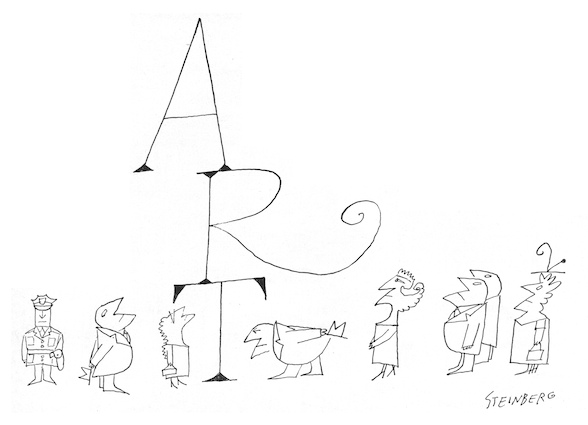
Robin Lindley: Who are some of your favorite cartoonists or your influences as a cartoonist?
Bob Mankoff: Steinberg was an extraordinary influence on me, and European cartoons. In the book, I show that all my first cartoons were strictly visual. I had come from graduate school and that was very conceptual. I had many influences getting into cartoons, but after a while, my main influence was the freedom The New Yorker gave me with the idea that you could attempt anything. But to attempt it, it wasn’t by looking at somebody else; it would be by looking inside.
Robin Lindley: You were an accomplished artist in high school at a special school for the arts, but then you went on to study psychology and almost earned a doctorate. That must have informed your work.
Bob Mankoff: Let me correct you. I was at a special school for the arts, but within that context I was far from special as an artist. Whatever specialness I had or have comes from combining my art with my humor.
And yes, my background in psychology has influenced my outlook. In the book, I talk about that and I got back to studying humor theory. I’ve published some papers on humor theory and I try to share some of that information, but not too tedious, in the book. I go to academic conferences on humor and research.
Robin Lindley: You describe the artistic process, and it seems your words in the book would be of value to any creative artist, whether a visual artist or a writer.
Bob Mankoff: Yes. When you look inside there permutations and iterations and getting a sense of how much work is involved. I try to convey how much work is involved in being a cartoonist. It’s not nine to five but it’s a creative act and it means every day you try if you’re a cartoonist.
If you’re a cartoonist, even when you’re not at the drawing board, you’re a cartoonist. You have a full time job to see these things.
As I describe in the book, my job is changing. I don’t have time to cartoon anymore. In a way, I’m not that interested anymore because I’m seeing this new generation and that’s where I’m trying focus my energy. At a certain point you go from being a player to a player-coach and then, all of a sudden, you’re basically coaching. You feel that all your creative energy goes to “how can I make this person’s cartoons better. What can I tell them to do?”
And I’m just blown away by what the other people are doing. It’s awe inspiring to me—the creativity and passion that they’re bringing to this oldest running, continuous comic tradition in America. We’ve been here since 1925.
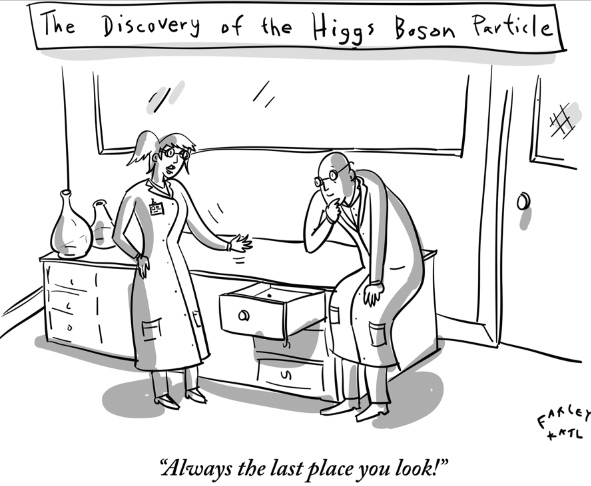
Robin Lindley: How do you see the evolution of New Yorker cartoons and how they’re different with new artists today?
Bob Mankoff: I think, with all the stimuli, they’re more absurd, more weird, on one end. They’re taking old clichés and rejuvenating them. Like this cartoon by Joe Dator showing a man on a desert island throwing a bottle in the water and he’s saying “I should have spent less time writing about fantasy sports.” He’s bringing the new and old together in these old forms.
One of the wellsprings is incongruity—things that don’t make sense. That’s what the world is. We’re bombarded by incongruity, strangeness and silliness that we are numb to because there is so much of it. It’s out there whether on the Internet or the millions of images that are constantly assailing us. Sometimes all it needs is the slightest tweaking to make it funny.
Of course, as a cartoonist, you sometimes insert the incongruity and strangeness. I was telling Colin [Colin Stokes, Mankoff’s assistant cartoon editor] that I just gave a talk to Google. I wore this Velcro camera you strap on your head, and as Google was taping me, I was taping them. One of the things is to make people aware of absurdity to stimulate them and to give them a perspective on how not to take themselves seriously. It doesn’t mean we’re not serious or don’t try to accomplish things, but it’s the realization that the play of humor while enjoyable for it’s own sake also has many other ancillary benefits–cognitive, emotional, even spiritual.
Over it all, unfolding in life, there is this cosmic joke of our frenetic nature—as Shakespeare said, “full of sound and fury signifying nothing.” That’s a little strong Bill. I don’t want to go that way. But you see these speeded up pictures of people. Everything looks funnier speeded up. We’re here in a second and we’re gone in a second. It seems a long time. All of our frenetic energy is against this existential background of never having existed. One way to look at it is that for billions of years you weren’t here, and for billions of years you won’t be here. Mathematically, you’re not here at all.
So you need some kind of perspective on it all. Absurdity in and of itself will just annoy us, but we can also enjoy it if we have a humorous perspective. Being in an airport is a prescription for comedy because absurdity is compounded by annoyance and frustration.. Let’s say you’re waiting to get on the plane and you have an ordinary ticket—economy or whatever they call it. If you have humorous frame of mind, they’re calling “Now our gold-plated, premium, wonderful people can enter.” And that’s not you. And then there’s a whole group of people who were not as good as that first group that get on, who are also not you. Then finally there’s a line for you: “Scum of the Earth.” And you can sit with luggage.
Thinking of these things and making it worse than it is actually makes it funnier and makes it tolerable.
Robin Lindley: I’ve also talked with Victor Navasky on his book The Art of Controversy on the enduring power of political cartoons—and the power of humor.
Bob Mankoff: I think our work endures more. All that stuff gets washed away. The human condition remains the same. The humor which is redirected back to us as human beings remains timeless. The humor directed toward Nixon or King George the Third, not so much, [because it targets] a specific person.
Also, I think humor has more power to change and give perspective to us when it’s directed to us. I’m not against speaking truth to power through humor but I don’t think power has ever picked up that call.
And that [political] humor is very dependent on what you’re disposed to. I was part of a documentary on Herblock. Everybody on the left side of the equation loved Herblock but people who worked for Nixon or who worked on the other side didn’t.
So much depends on your point of view. But in a Roz Chast cartoon a guy looks at an obituary [newspaper page] saying: “Two years older than you. One year younger than you. Your age on the dot.” Everybody understands that and everybody can relate to it—just like everybody will relate to her book about the decline of her parents.
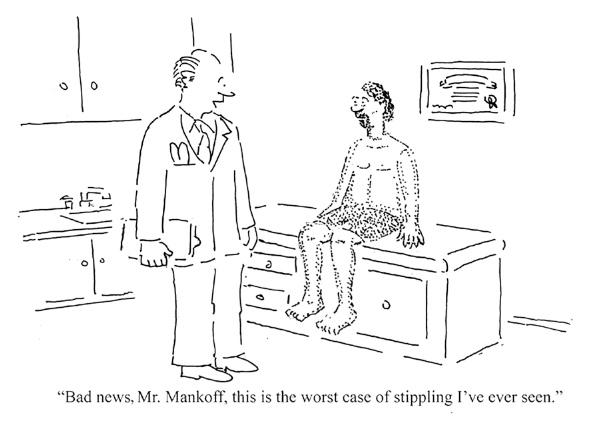
Robin Lindley: Did you ever try standup?
Bob Mankoff: I never did because I became successful as a cartoonist almost immediately. I was tempted and I could have gone off to the Borscht Belt and go back with fear and loathing to the places I went to as a kid but my humor wouldn’t have been right for that. So that was a road not taken.
Now I may tour geriatric facilities where people can still relate to the fact that I just turned seventy.
Robin Lindley: Congratulations.
Bob Mankoff: It’s better than the alternative, as they say. I thought of some jokes. The good news is, seventy is the new fifty. The bad news is, dead isn’t the new alive. Another joke I used in a tweet: “Just turned 70. The good news is: it could be worse. The bad news is: it will be.”
So, that will be the beginning of my standup routine for my tour of old age homes. I hope I’ll do well but I’m going to lawyer up in case anyone dies laughing. I’ll make sure my legal team attributes it to a pre-existing condition.
Just kidding around here (it’s what I do) but I actually might give it a go. If it works out great, and if it doesn’t, well, maybe there’s another book in it.